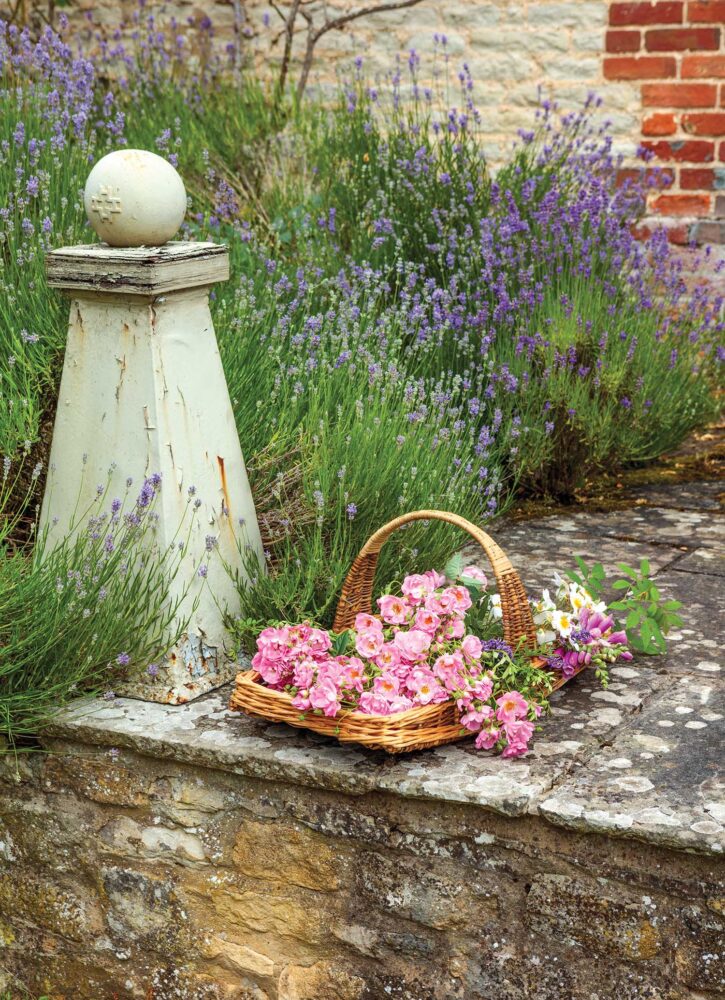Take a quick scroll through your favorite design follows on Instagram or Pinterest, and you’re likely to come across inspiring images of interiors with eclectic arrangements of art, referred to as gallery walls. Within a New York minute, searching #gallerywall on Instagram leads to over two million posts alone. Although hardly a 21st-century decorating invention—they first came into vogue in the salon exhibitions of 17th-century France, hence why they’re also known as salon walls—today, gallery walls are an ideal way for designers and collectors to infuse art, style, and personality into their rooms. Loosely defined as a diverse mix of paintings, photographs, prints, and the like arranged in a grouping, they’re as varied and personal as the individuals who create them. We’ve asked three interior designers and a pair of art-gallery professionals to get down to the brass tacks on why they love gallery walls, what makes them work, and how they go about arranging them. If you’re contemplating creating one of your own, you’ll want to hang on to their advice.
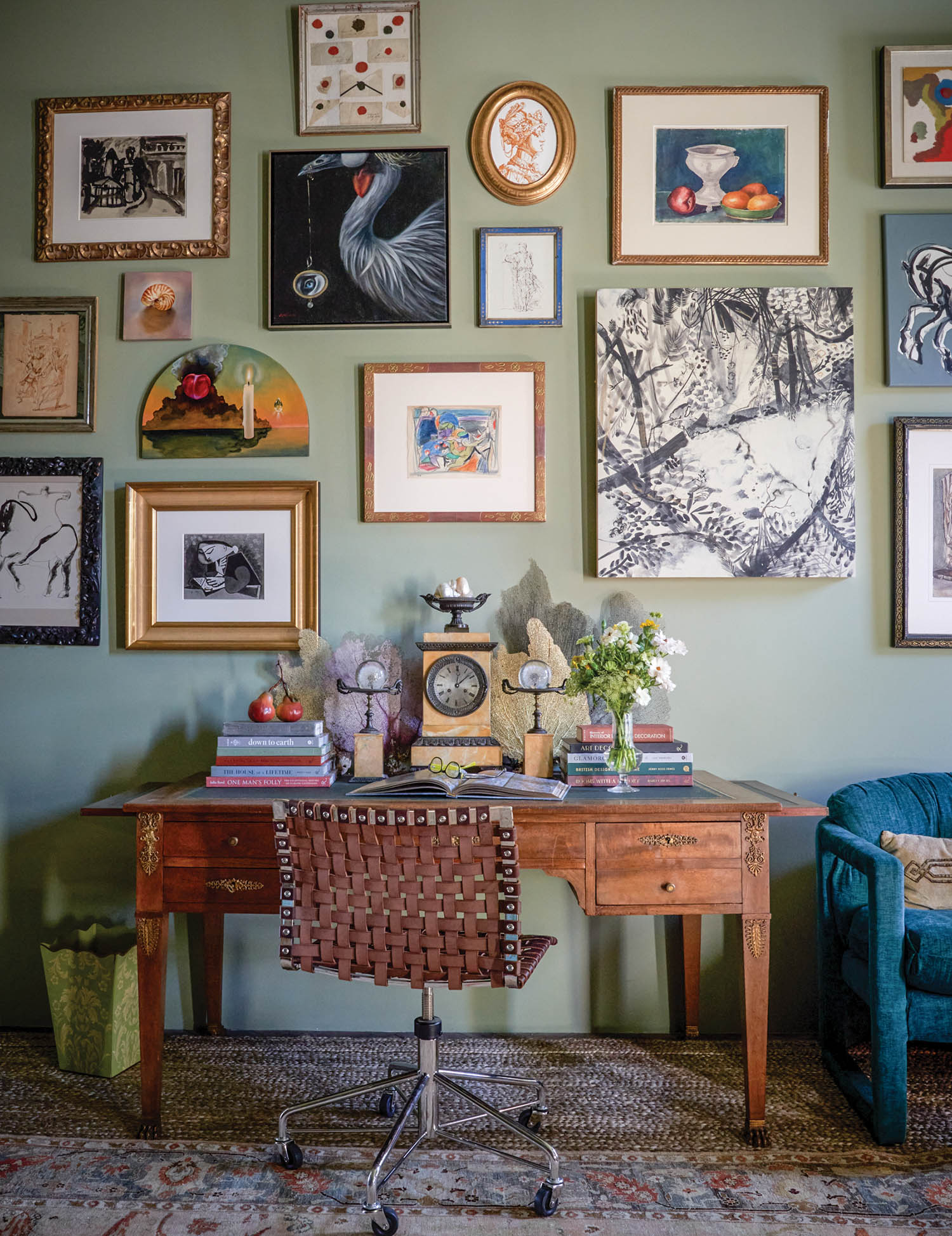
Photo by Paul Costello
aura Roland collaborated with Ann Connelly Fine Art on the gallery wall in the library at the Baton Rouge Showhouse.
FLOWER: WHAT DISTINGUISHES A GALLERY WALL FROM OTHER STYLES OF ART ARRANGEMENTS?
Laura Roland, Baton Rouge designer: A collection of art hung in an ordered grid perhaps is technically considered a gallery wall, but for me, a true gallery wall tends to be looser. When I’m hanging things in a symmetrical manner, it’s typically a series of small works, such as antique prints of all the same subject matter in the same frame and matting to read as one piece. A gallery wall is meant to be more diverse and even moved around. It can be re-created in a different way in another room and take on a completely new look.
Mallory Mathison, Atlanta designer: For me, what most defines a gallery wall is asymmetry. I consider something like a set of botanicals prints from the same artist hung in a symmetrical grid a grouping—the gallery wall’s first cousin. A gallery wall should be a collection of different things, even if they are similar in subject matter.
Ann Connelly, owner of Ann Connelly Fine Art in Baton Rouge: If you look at the early industrialists and their collections, it appears as if things were just plopped on the wall, which is the feeling a salon wall is meant to evoke. They should look non-structured and organic, but the truth is we know they rarely come together by happenstance.
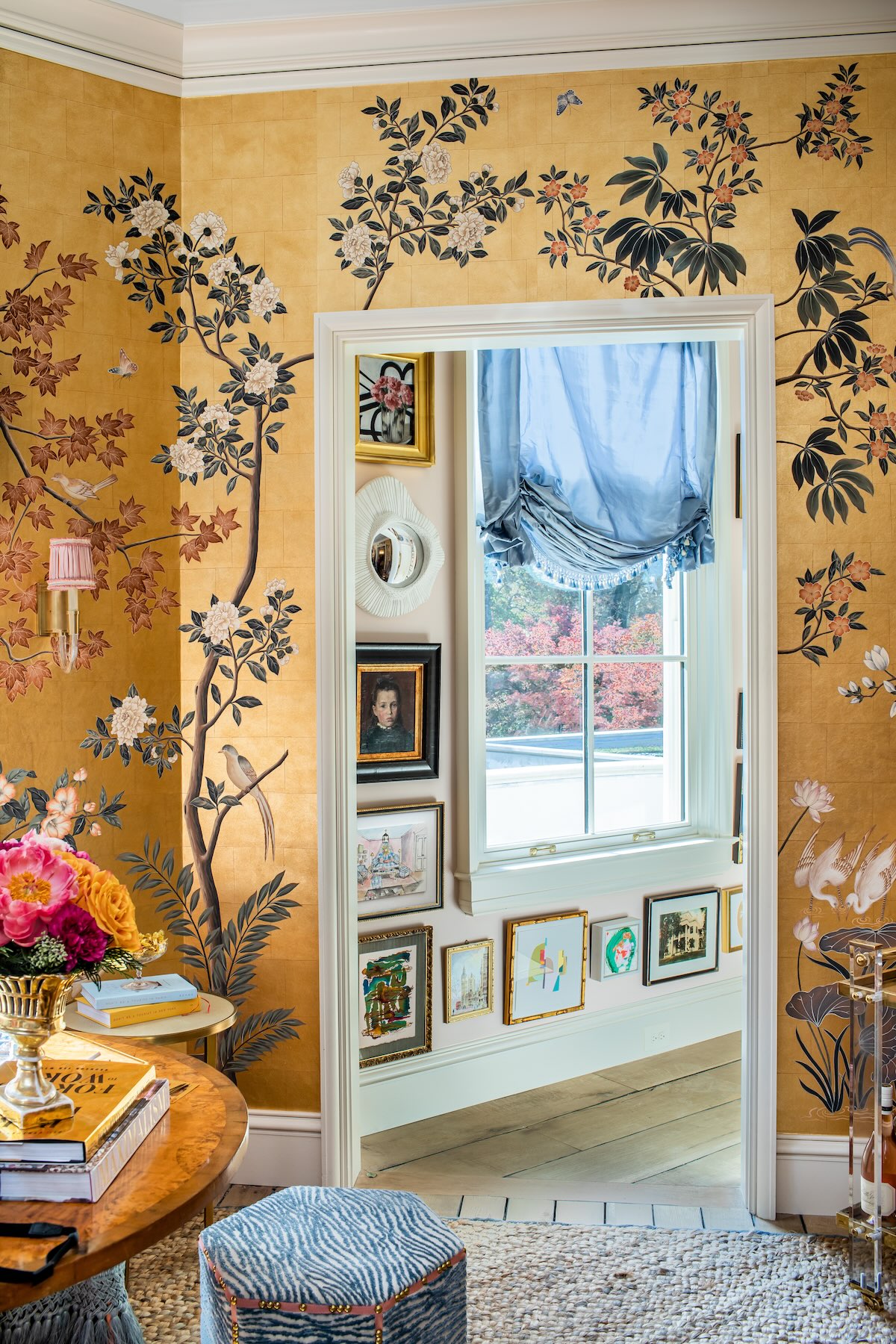
Photo by Jeff Herr
Mallory Mathison added interest to an adjoining hallway with a gallery wall at the FLOWER Atlanta Showhouse.
WHAT DOES A GALLERY WALL BRING TO THE ROOMS YOU DESIGN, AND WHY DO YOU LOVE THEM?
Fran Keenan, Birmingham designer: I love a collection of anything, especially art. When I’m faced with an expansive wall and wonder how in the world we’re going to fill it…eureka—a beautiful gallery wall is the answer. And even better, let’s light it!
Laura: Artwork says a lot about someone because it’s so personal. Gallery walls can be a cool way to showcase the things clients collect on their trips, those small pieces they bring home with them that we’ll then have framed in a really interesting way. The best gallery walls don’t happen overnight. They reflect the journey of collecting over time—sometimes a lifetime.
Mallory: I’m thinking about them for almost every project we do, especially if the clients are coming in with a lot of various pieces of art. A gallery wall creates an immediate story. If a homeowner has a lot of smaller or medium sizes of artwork and a lot of big walls, it’s much more impactful to consolidate pieces rather than scatter them here and there. You get an immediate sense of gravitas and a layered feel that a singular piece of art doesn’t always achieve.
Ann: I’ve loved gallery walls forever, and they’re really what started my business. They establish a visual and emotional language for a room. My favorite part is helping a homeowner tell their personal story through collections of things that are their reference points. Why did they select each piece? Where have they traveled? What memories do these things evoke?
Chelsea Norris, co-director of Ann Connelly Fine Art, Baton Rouge: It’s rewarding to help people develop their style and gain confidence with art. It could be a client that Ann started working with 15 years ago, and now I’m working with them and watching them continue to add to their collection. I think what holds a lot of people up is they feel confined to rules—I can’t go this high; I can’t go this low; I can’t mix the frames. We want to help bring people out of that and make them comfortable.
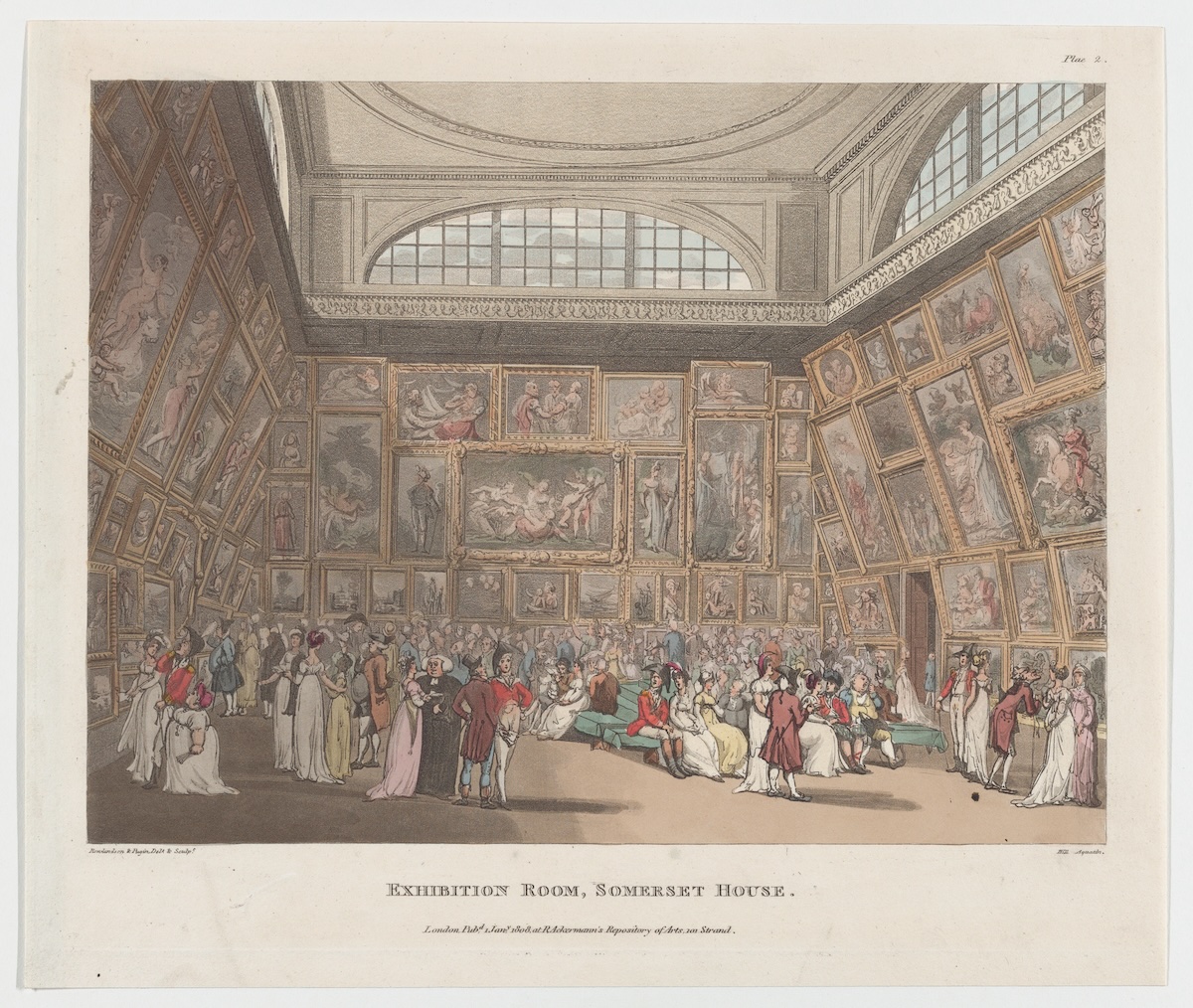
Photo courtesy of the Metropolitan Museum of Art
Gallery walls first came into vogue in the salon exhibitions of 17th-century France, hence why they’re also known as salon walls. The style of arranging spread across Europe and eventually across the pond to the U.S.
WHILE GALLERY WALLS ARE GENERALLY ECLECTIC BY NATURE, IS IT IMPORTANT TO HAVE SOME KIND OF UNIFYING THREAD THROUGHOUT THE ELEMENTS?
Ann: It can be as individual as the person creating it. The main consideration is scale—you must scale the artwork to fit the room, and that’s where a professional eye is helpful.
Mallory: I love a collection of antique maps from different time periods. Some could be sepia and some colored—all with different sizes, places, and frames. However, I also love taking the approach of pulling together a mix of oil paintings and watercolors, objects on brackets, photography—a catch-all of anything. But those are trickier to keep from looking chaotic. You want it to feel interesting and collected, but not a hot mess. Creating a sense of effortlessness can require the most planning.
Fran: I often use color as an underlying theme, but it’s not required. Some of the most beautiful gallery walls we’ve done have come together serendipitously. It should reflect what you’re passionate about. If you’re drawn to 19th-century landscapes, then start collecting them. As your collection grows, they’ll be so powerful hung together or around a lovely commanding mirror.
Laura: Something needs to unify them, and I have some general rules of thumb. You can do all one theme, such as still lifes, botanicals, or landscapes. Or it could be the frames—not that they’re all the same, but maybe they’re all antique or have an element of gilt. Or perhaps half the pieces are canvases with no frames and the other half are framed works on paper. I wouldn’t do just one canvas with everything else under glass. A few of them have to connect to each other to get in the group.
Mallory: I did one for a showhouse in Charleston where it was all portraits of women, from line drawings to oils to watercolors. You could do the same with landscapes or florals. A similar theme lends itself more easily to feeling soft and cohesive. It depends on what your final goal is. In my own stair hall, I’ve hung everything under the moon from floor to ceiling—it definitely feels quirky and interesting. For me, that’s a positive thing—but it isn’t always for my clients. I do what feels most comfortable for them.
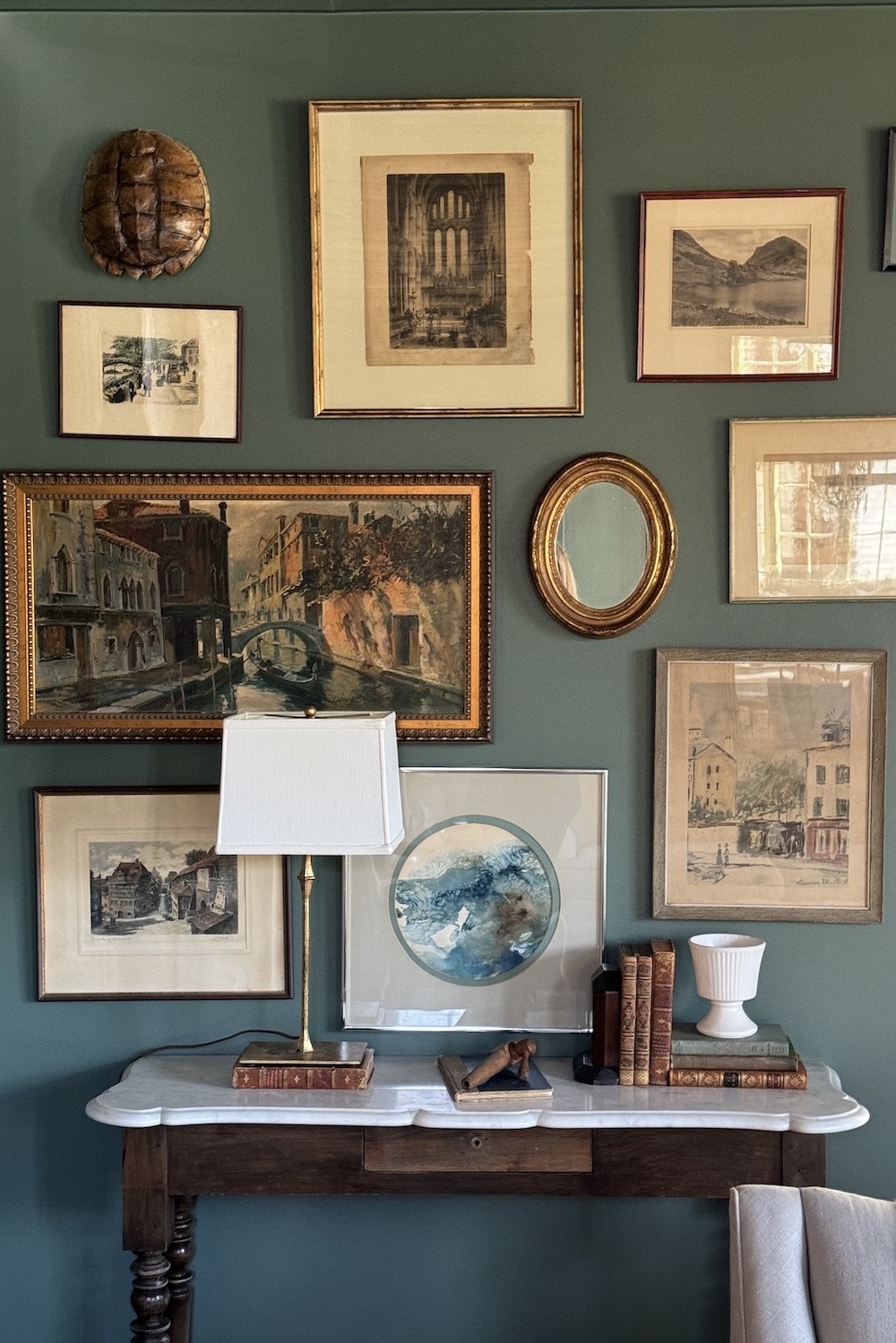
Photo courtesy of Fran Keenan
Mixing and matching antique prints can add to the salon-feel of a gallery wall.
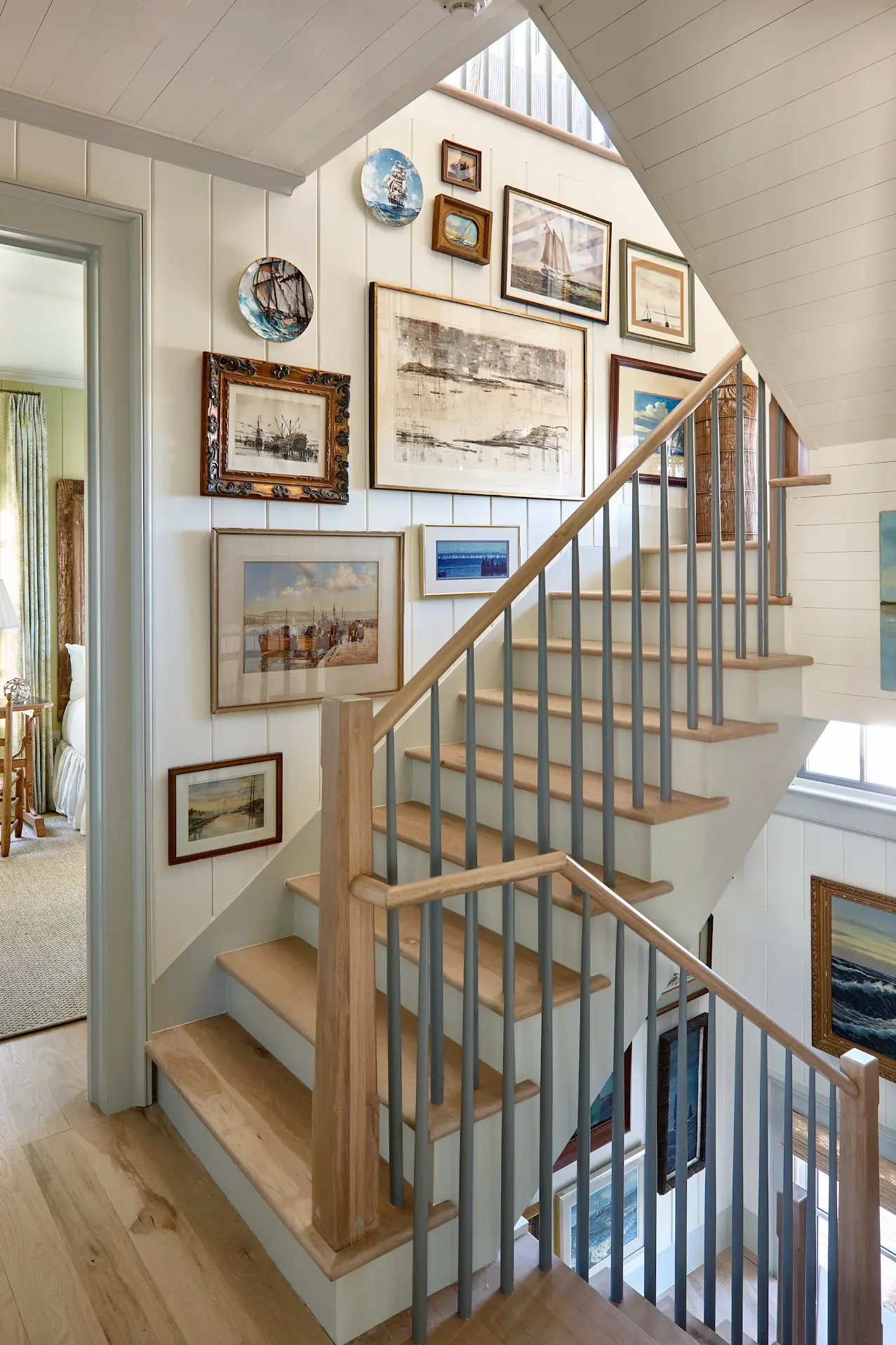
Photo by Hector Sanchez
The coastal theme was the common thread for this staircase gallery wall.
DO YOU MIX IN OTHER OBJECTS WITH THE ARTWORK, AND IF SO, HOW?
Ann: The salon wall is now growing past two dimension. It becomes more interesting when you mix a bas-relief, a three-dimensional object that’s suspended from the wall, or a mirror that has a lot of carving.
Fran: I do like to mix other elements; however, I only hang dishes on walls in rooms that you eat or serve food in.
Laura: I’ve incorporated everything from pottery to sculpture to clocks. For my library at the FLOWER showhouse, we had an octagonal mirror in a burl wood frame. We took the clear mirrored glass out and replaced it with a smoky acrylic, which had a bit of a reflective effect but was very hazy. We wanted the mirror to be appreciated as a piece of art in itself.
Mallory: I’ll incorporate a bracket with a decorative plate or ceramic vase on it, or I’ll hang a round basket. When you mix in three-dimensional objects, it adds another layer. Another thing we’re doing more of now, given we’re not as concerned with trying to hide the TV these days, is building a gallery wall around a Samsung Frame television, whether we actually display an image on the screen or leave it black.
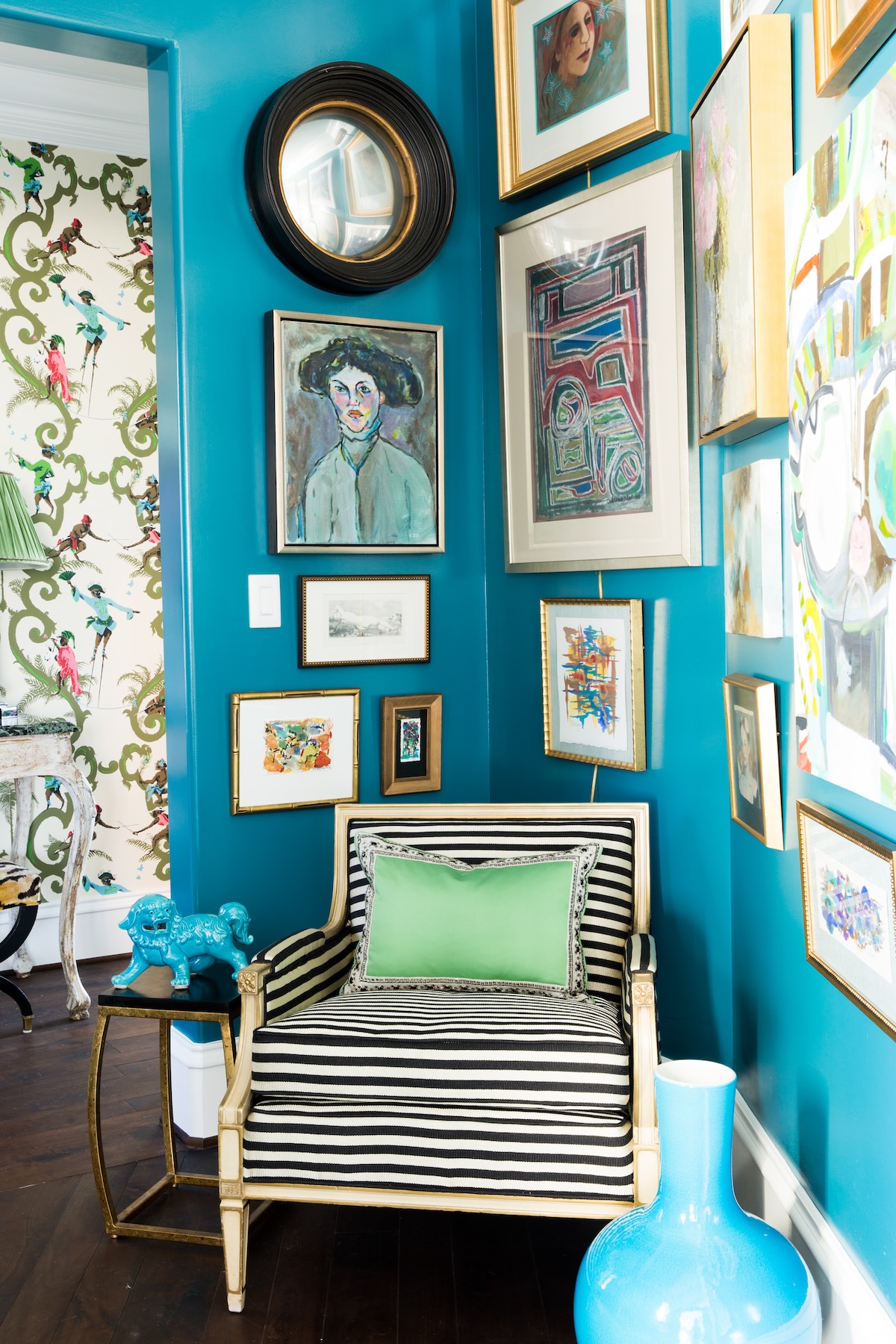
Photo courtesy of Mallory Mathison
Even a corner can make a great spot for a gallery wall.
LET’S TALK ABOUT THE ARRANGING PROCESS. WHAT’S YOUR METHOD FOR WORKING OUT THE COMPOSITION?
Fran: If I’m creating one for my own house, I’m throwing things up while I’m stirring noodles for hungry teenagers! When it’s for a client, I measure where it’s going to go and then put the tape measure on the floor to place the art in the same dimensions it will fit when it hangs on the wall. I sort through the pieces and see what works well together. I look at which pieces have a colored mat—or if there are several white mats, I want to make sure I’m not putting all like things together at the same end of the arrangement but instead evenly distributing them across the composition. I start by placing the two or three largest pieces strategically spread out to make room for smaller pieces to be tucked in between the larger ones. Then I work my way out.
Ann: When I’m creating one for the gallery, I often begin with a triadic relationship, figuring out three pieces and why I like them together. I’ll start from the central point and then radiate out from there, depending on the overall size I’m trying to hit. When a client comes in, often with their designer, to work through one for their home, it’s collaborative. We’ll start arranging on the gallery floor and then take off our shoes and get up on a ladder to get a look from above.
Chelsea: No two gallery walls are ever the same, and the method varies. When all the pieces are good, there are multiple ways to put them together. We’re using so many new tools given many of our clients are no longer right around the corner from us. I’ll utilize Photoshop and AI-driven software programs to help me accurately portray how art installations will look in real spaces. Clients can send me a straight-on picture of the space, the dimensions of the wall, and any furniture to be incorporated, and I augment in artwork to scale and show how it will be matted and framed. But just as often, it’s still a hands-on approach and we’re arranging and moving pieces around on the floor with a client to see how the arrangement will take shape. Sometimes I take a bookend approach, starting left and right to establish the dimensions and make sure I’m staying within bounds, and then fill in in-between. And then other times the process might start with people who have multiples of things—15 botanical prints, for example—and we need to make it feel more interesting and fresh. Our first course of action often is to choose three or four of them (the rest will find a home elsewhere in the house) and add in other kinds of pieces to break up the idea of an expected grid.
Mallory: I know designers who make templates of every piece and tape them to the wall first, which is interesting to me but not my method. When I’m arranging for a client, I lay everything out on the floor and start creating the composition. I usually don’t start in the middle, but I do begin with the anchor piece, which I’ll typically place over to the right, a little bit higher or lower than eye level. When I’m creating a gallery wall in my own home, I’m a little less studied. I’ll just follow my gut and start nailing things up. If you do it that way, you’ll end up having to move a few things around—so if you have beautiful wallpaper or freshly painted walls, it might not be worth the risk!
Laura: I usually begin with the largest work, but if I have a piece of furniture that anchors the wall, such as the desk in the library in the FLOWER showhouse, I’ll start with whatever I’m hanging over that and then go from there.

Photo courtesy of Ann Connelly Fine Art
Oftentimes, one element of a gallery wall, such as similar golden frames, helps pull it together for a cohesive look.
DO YOU NEED A CERTAIN NUMBER OF PIECES TO CREATE A SUCCESSFUL ARRANGEMENT?
Laura: It just depends on both the size of your space and what you love. The best ones are when they’re either relatively minimal or all over the wall—sometimes it’s the in-between when it feels wrong. I say, “Go big or go home.” There definitely have been times when I’m putting one together and it feels like we don’t have enough, so I stop because we don’t have the balance or right mix of shapes. If that’s the case, it’s better to hang the art wherever it looks best in the house and keep collecting before you graduate to a true gallery wall.
Mallory: You can begin to get the feel of a gallery wall with three things, but then you can go up to infinity!
ARE THERE SPECIFIC ROOMS OR SPACES WHERE YOU PARTICULARLY LIKE TO INCORPORATE GALLERY WALLS?
Mallory: Stairwells, hallways, powder rooms. That’s not to say I won’t create one in the living room, but I love those pass-through spaces where you actually have to pause to look rather than stare at it from the sofa. You can take in something different each time.
Laura: They can be anywhere, but I believe they’re most successful when there aren’t a lot of other things around them. I don’t do them next to open bookshelves, for example, or other kinds of more cluttered areas. I often like them to stand alone and be the showstopping element in the room.
Fran: On a wall that covers a dramatic piece of real estate and feels like it needs a melody or thread to pull all of the adjoining rooms together through color and art that relate to the house’s overall palette.

Photo by Hector Sanchez
Fran Keenan used a gallery wall in the Atlanta Showhouse Gym to energize and elevate what is usually a purely practical space.
WHAT ROLE DOES THE FRAMING OF THE ART PLAY IN CREATING AN EYE-CATCHING WALL?
Ann: It’s critical. Frames can really make magic for individual pieces and for the wall as a whole. They can amplify a work or tone a strong painting down. But the frame has to balance well with what’s in it. For example, you wouldn’t want to have a chunky Florentine frame with a very pale drawing. You want to pop that with a more saturated piece of art that can hold its own with the weight of the frame.
Chelsea: As much time as you spend collecting and curating the art, you should spend equal effort in selecting the frames. We’re a specialty framing gallery, and we collaborate with artisans who make frames by hand in the European style. It’s rare that I’m not using one or two of these highly specialized frames, in addition to antique and vintage ones we source. They’re what can really set off a salon wall.
Laura: When I’m buying, sometimes I’ll find a good piece of art and the frame is also good, but they’re just not working together. I have to separate the two in my mind. Perhaps I’ll put the antique painting in a less ornate frame and then choose something really contemporary for a very decorative frame. I like that tension.
Mallory: We’re never doing all matching frames, but they should be complementary. For instance having all of them have some element of gold in them can be a unifying factor when we’re working with a lot of different mediums. It’s great to mix old frames with new ones, but I wouldn’t take a lot of pretty gold vintage frames and throw one white lacquered one in. You want to keep it where it feels thoughtful, but also like it’s been collected in stages. I do believe that creating a sense of effortlessness can require a lot of planning.
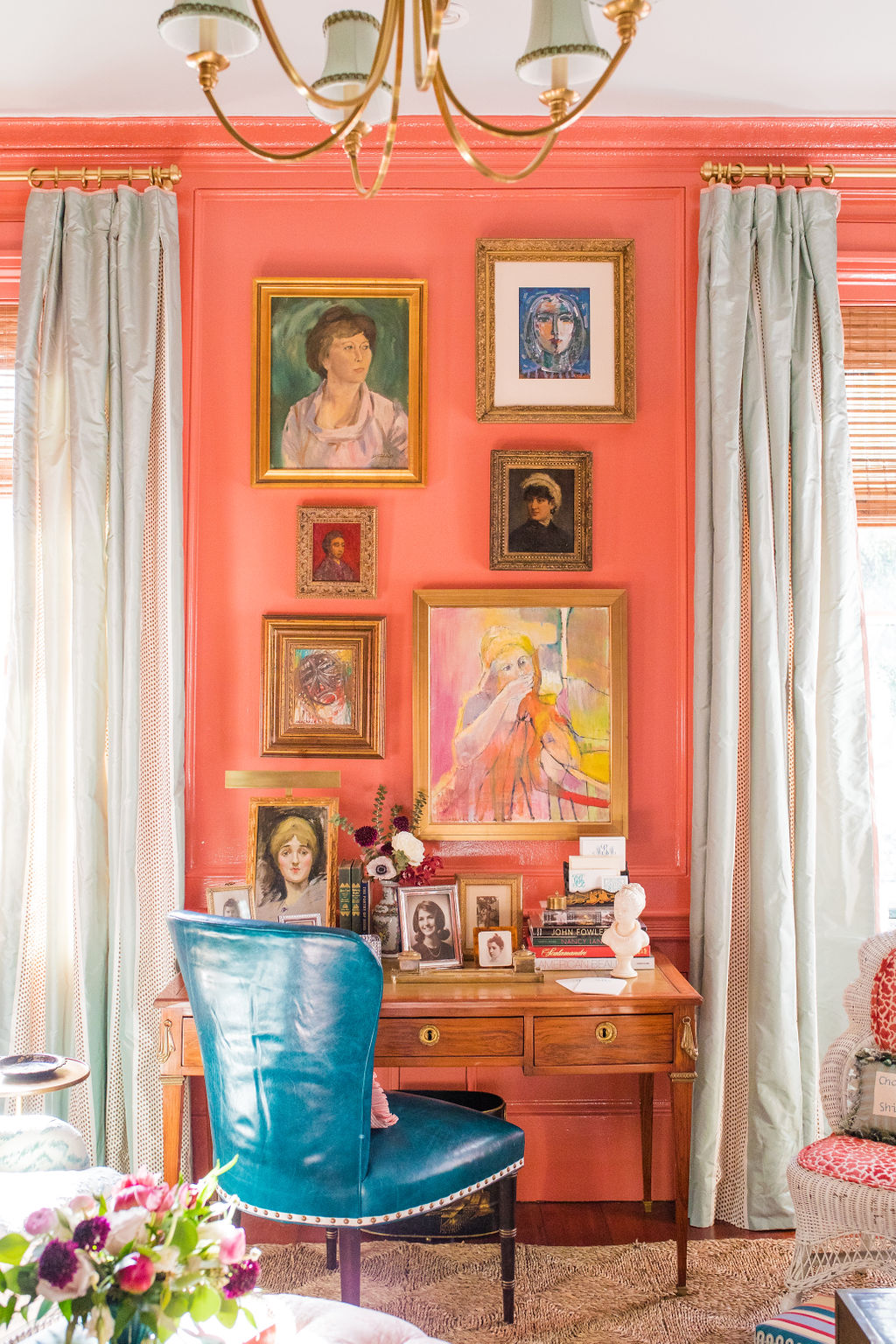
Photo courtesy of Mallory Mathison
Colorful portraits of women is the theme for this fun gallery wall.
FINALLY, PLEASE SHARE YOUR BEST PIECE OF PARTING ADVICE.
Mallory: Consider repetition of shape rather than repetition of specific objects. Most art will either be squares or rectangles—that’s just the way it is. You can introduce and play with other shapes through circular mirrors, plates, and baskets, or with triangular brackets or vases.
Chelsea: Go slow. Gallery walls are usually most successful when they evolve over time rather than buying everything all at once. Establish the arrangement to the point where it looks cohesive and complete but also leave room to inject things you find down the road.
Laura: The most common mistake I see is when the composition is weighted wrong. I’ll squint my eyes and maybe it’s too heavy on one side. It needs to be balanced. It helps to take a photo with your phone instead of staring at the wall. That allows you to disconnect and see things a little more clearly. Artists often do that when they’re painting—they step back and take a picture for a little more clarity on what needs to happen.
Ann: Think about your eye level and also how the arrangement connects to any furniture it’s close to or surrounding. You don’t want things to be floating too high.
Fran: Unless it’s truly a collection of similar works, nothing will look like it goes together until you hang it on the wall. If all the pieces mean something to you, then you and your loved ones are the theme. Pull them all together and just enjoy.
Produced by Karen Carroll
FEATURED DESIGN EXPERTS

Photo courtesy of Mallory Mathison
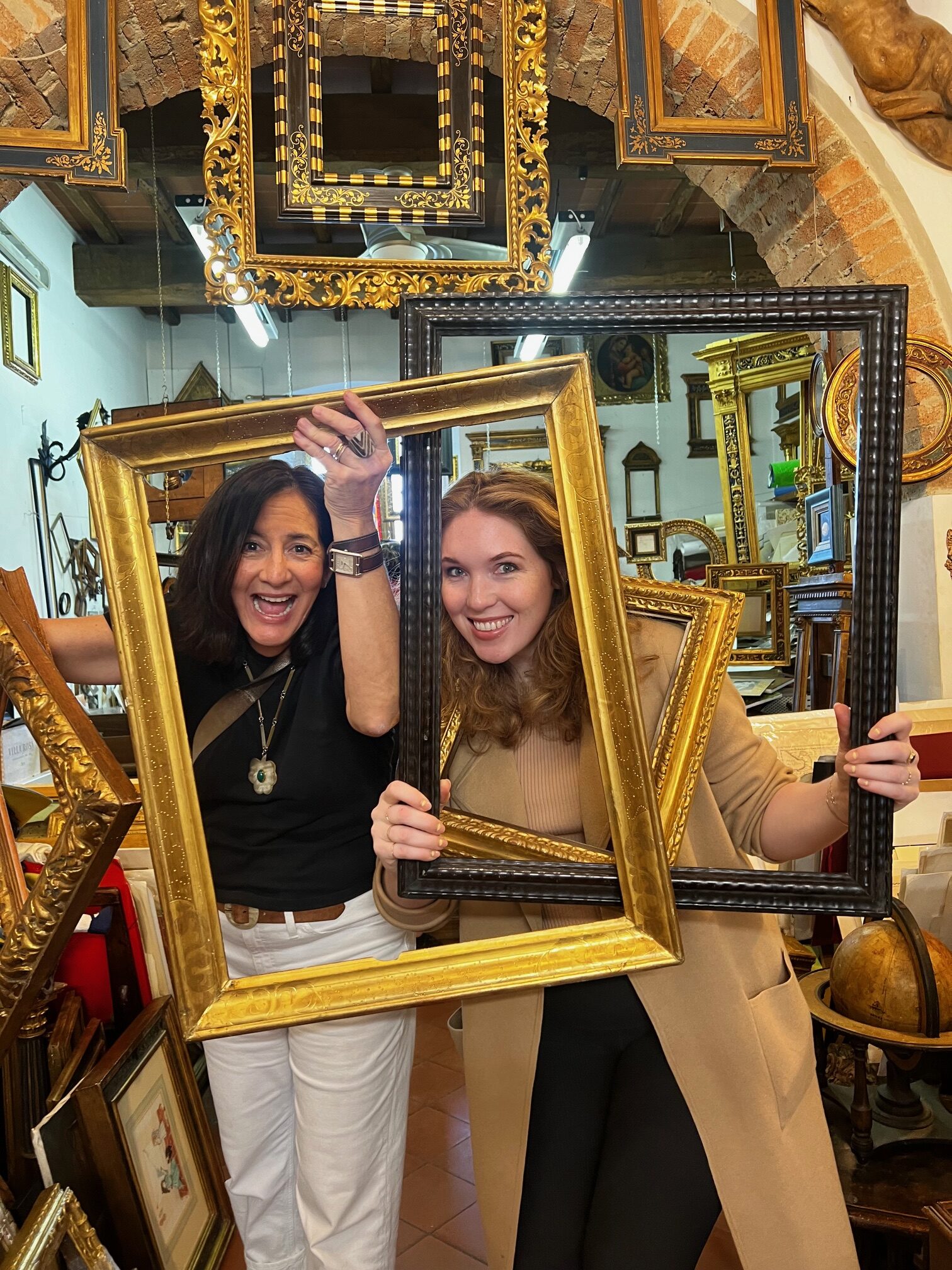
Photo courtesy of Ann Connelly
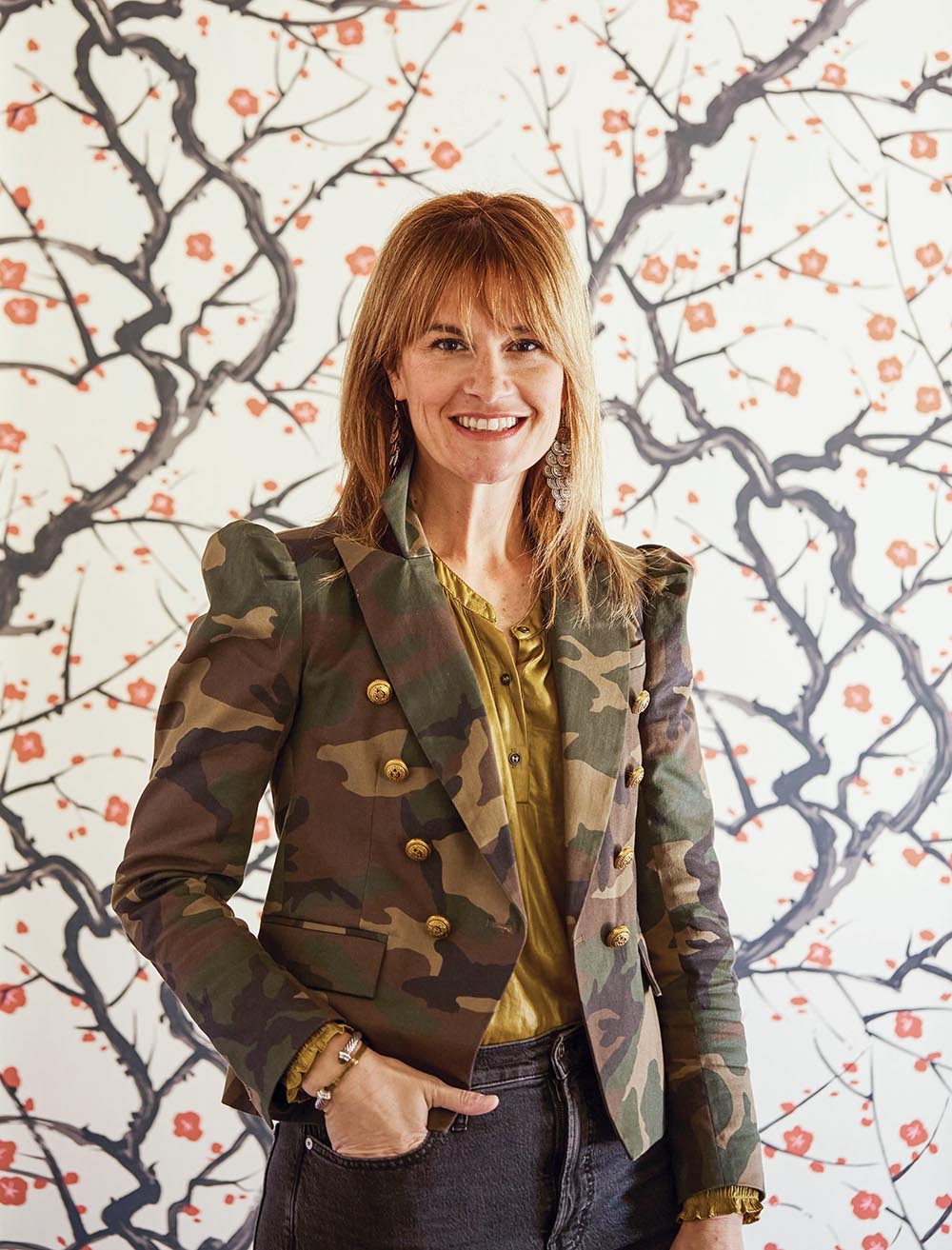
Photo courtesy of Fran Keenan

Photo courtesy of Laura Roland
Mallory Mathison of Mallory Mathison Inc.
Instagram: @mallorymathisoninc
Ann Connelly and Chelsea Norris of Ann Connelly Fine Art
Instagram: @annconnellyfineart
Fran Keenan of Fran Keenan Design
Instagram: @frankeenandesign
Laura Roland of Laura Roland Interiors and Fireside Antiques
Instagram: @laurarolandinteriors and @firesideantiques



